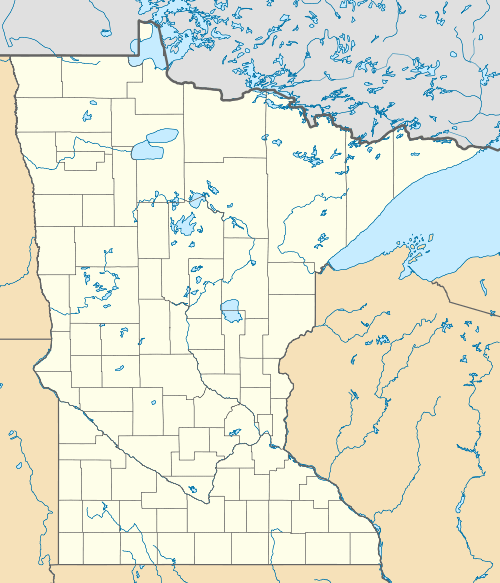Thorstein Veblen Farmstead
|
Thorstein Veblen Farmstead | |
|
The farmhouse in 2014 | |
  | |
| Location |
16538 Goodhue Avenue Nerstrand, Minnesota |
|---|---|
| Coordinates | 44°20′52″N 93°02′49″W / 44.34778°N 93.04694°WCoordinates: 44°20′52″N 93°02′49″W / 44.34778°N 93.04694°W |
| Area | 10 acres (4.0 ha) |
| Built | 1867-1870[1] |
| Architectural style | Second Empire |
| NRHP Reference # | 75001024[2] |
| Significant dates | |
| Added to NRHP | June 30, 1975[2][3] |
| Designated NHL | December 21, 1981[4] |
The Thorstein Veblen Farmstead is a National Historic Landmark near Nerstrand in rural Rice County, Minnesota, United States. The property is nationally significant as the childhood home of Thorstein B. Veblen (1857-1929), an economist, social scientist, and critic of American culture probably best known for Theory of the Leisure Class, published in 1899.[5]
Description and history
The Veblen farmstead stands east of Nerstrand in far eastern Rice County, off Goodhue Avenue north of Minnesota State Highway 246. Now reduced to 10 acres (4.0 ha), the property includes a house, chicken coop, granary, and barn with attached milking shed. The house, granary, and barn, were all built by Thomas Veblen, in the 1870s and 1880s. The house is a two-story frame structure, with a side gable roof, two chimneys, and clapboard siding. A single-story porch extends across the front, supported by square posts, with a balcony above. The granary is a small two-story clapboarded frame building, measuring about 25 by 30 feet (7.6 m × 9.1 m). The barn is two stories, and has a gabled roof.[5]
Thorstein Veblen, born in Wisconsin in 1857, lived on this farm (homesteaded by his parents) as a youth and returned often as an adult, due in part to his inability to land a job, despite college degrees. The product of an austere agrarian upbringing, Veblen has often been called one of America's most creative and original thinkers.[6] He coined the term "conspicuous consumption." The property's simple vernacular styling illustrates early influences on Veblen's life as the son of immigrants, growing up in a tightly knit Norwegian-American community. His book, Theory of the Leisure Class is distinguished by economic, social, and literary scholars.[1]
The Veblens sold the property in 1893 and it continued to be an active farm until 1970, when the buildings fell into disrepair. The house has now been meticulously restored and the Preservation Alliance of Minnesota holds a preservation easement on the property.[7]
See also
- List of National Historic Landmarks in Minnesota
- National Register of Historic Places listings in Rice County, Minnesota
References
- 1 2 "Historic American Buildings Survey". Library of Congress. Retrieved 2010-12-13.
- 1 2 National Park Service (2010-07-09). "National Register Information System". National Register of Historic Places. National Park Service.
- ↑ "National Register of Historic Places". www.nationalregisterofhistoricplaces.com. 2007-10-31.
- ↑ "Thorstein Veblen Farmstead". National Historic Landmark summary listing. National Park Service. Retrieved 2009-09-03.
- 1 2 James Sheire (May 21, 1981). "National Register of Historic Places Inventory-Nomination: Thorstein Veblen Farmstead" (pdf). National Park Service. and Accompanying 4 images taken in 1971 (2.33 MB)
- ↑ "Thorstein Veblen Farmstead". National Historic Landmarks Program. National Park Service. Retrieved 2007-10-01.
- ↑ "Restoring a national historic landmark". Benchmarks in Minnesota's Historic Preservation. Minnesota Historical Society. Retrieved 2007-11-02.
